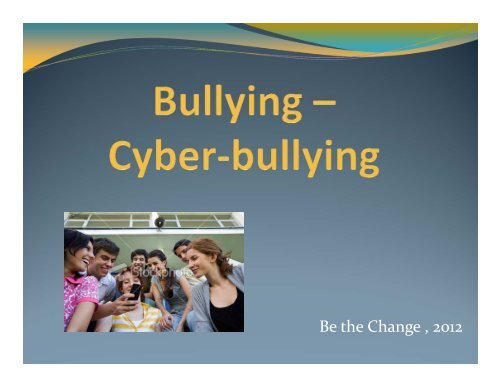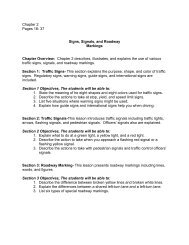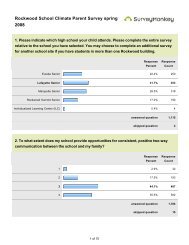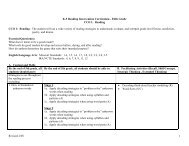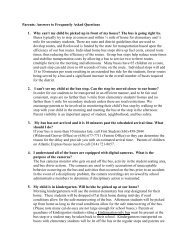Bullying and Cyberbullying - Rockwood School District
Bullying and Cyberbullying - Rockwood School District
Bullying and Cyberbullying - Rockwood School District
You also want an ePaper? Increase the reach of your titles
YUMPU automatically turns print PDFs into web optimized ePapers that Google loves.
Be the Change , 2012
What is bullying?<br />
• <strong>Bullying</strong> is unwanted, aggressive behavior among<br />
school aged children that involves a real or perceived<br />
power imbalance.<br />
• The behavior must be aggressive <strong>and</strong> include:<br />
• An Imbalance of Power<br />
• Repetition<br />
• There are three types of bullying:<br />
• Verbal bullying<br />
• Social bullying, sometimes referred to as relational<br />
bullying<br />
• Physical bullying
Frequency of <strong>Bullying</strong><br />
• There are two sources of federally collected data on<br />
youth bullying:<br />
• The 2011 Youth Risk Behavior Surveillance System<br />
(Centers for Disease Control <strong>and</strong> Prevention) indicates<br />
that, nationwide, 20% of students in grades 9–12<br />
experienced bullying.<br />
• The 2008–2009 <strong>School</strong> Crime Supplement (National<br />
Center for Education Statistics <strong>and</strong> Bureau of Justice<br />
Statistics) indicates that, nationwide, 28% of students<br />
in grades 6–12 experienced bullying.
Frequency of Cyber‐bullying<br />
• The 2008–2009 <strong>School</strong> Crime Supplement (National<br />
Center for Education Statistics <strong>and</strong> Bureau of Justice<br />
Statistics) indicates that 6% of students in grades 6–12<br />
experienced cyber‐bullying.<br />
• The 2011 Youth Risk Behavior Surveillance Survey finds that<br />
16% of high school students (grades 9‐12) were<br />
electronically bullied in the past year.<br />
• Research on cyber‐bullying is growing. However, because<br />
students’ technology use changes rapidly, it is difficult to<br />
design surveys that accurately capture trends.
What is cyber‐bullying?<br />
• Cyber‐bullying is bullying that takes place using<br />
electronic technology.<br />
• Examples of cyber‐bullying include: mean text<br />
messages or emails, rumors sent by email or posted on<br />
social networking sites, <strong>and</strong> embarrassing pictures,<br />
videos, websites, or fake profiles.
What is Cyber‐bullying? video<br />
• What is Cyber‐<strong>Bullying</strong>
Why is cyber‐bullying different?<br />
• bullied in person or alone<br />
• have a harder time getting away from the behavior<br />
• it can happen any time of the day or night<br />
• messages <strong>and</strong> images can be posted anonymously <strong>and</strong><br />
distributed quickly to a very wide audience<br />
• it can be difficult <strong>and</strong> sometimes impossible to trace the<br />
source<br />
• deleting inappropriate or harassing messages, texts, <strong>and</strong><br />
pictures is extremely difficult after they have been posted<br />
or sent
Can’t take it back video clip<br />
• Can't Take it Back Video Clip
Kids who are cyber‐bullied are<br />
more likely to:<br />
• Use alcohol <strong>and</strong> drugs<br />
• Skip school<br />
• Experience in‐person bullying<br />
• Be unwilling to attend school<br />
• Receive poor grades<br />
• Have lower self‐esteem<br />
• Have more health problems
Broken Friendships video clip<br />
• Real Life Stories ‐ Broken Friendship Video Clip
Prevent Cyber‐bullying<br />
• Parents, teachers <strong>and</strong> students can prevent cyberbullying.<br />
Together, we can explore safe ways to use<br />
technology.<br />
• Assess bullying in your school.<br />
• Engage parents, teachers <strong>and</strong> students.<br />
• Create policies <strong>and</strong> rules.<br />
• Build a safe environment.<br />
• Establish a school culture of acceptance, tolerance <strong>and</strong><br />
respect.<br />
• Reinforce positive social interactions <strong>and</strong> inclusiveness.<br />
• Educate staff <strong>and</strong> students.<br />
• Build bullying prevention material into the curriculum <strong>and</strong><br />
school activities.
Responding to bullying<br />
• Stop bullying on the spot‐ send the message that it is not<br />
acceptable.<br />
• Find out what happened‐ Whether you’ve just stopped<br />
bullying on the spot or a someone has reached out to you<br />
for help, learn how to determine the best way to proceed.<br />
• Support the person involved‐ support all people involved to<br />
make sure the bullying doesn’t continue <strong>and</strong> effects can be<br />
minimized.<br />
• Be more than a byst<strong>and</strong>er‐ be a friend!
Pause before you Post<br />
• slogan developed by Jostens<br />
• Pause Before You Post Video<br />
• Be the change campaign to educate at Lafayette<br />
• make posters<br />
• other suggestions?


